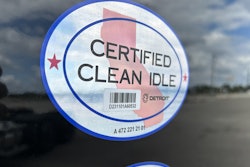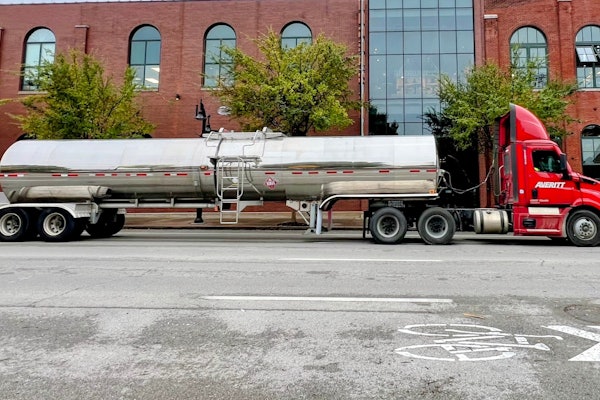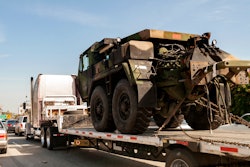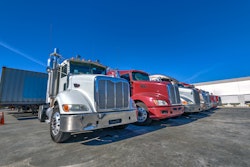A 1937 SAE Journal article by Pierre Shon titled Cab-Over-Engine Trucks — Their Place in Transportation, asks the question, “Were the original truck manufacturers on the right track 30 years ago when the ‘cab-over-engine‘ or, as called in those days, the ‘motor-under-the-seat’ type of design was considered standard practice?”
The article asks a second probing question. “Is the cab-over-engine truck design destined to take the place of the conventional type altogether, or will its adaptation be confined to a few vocational applications or a limited number of operators?”
Shon was writing as an engineer who worked at the General Motors Truck & Coach Division which formerly was the Yellow Truck & Coach Mfg. Co.
Cab-overs are not new to the U.S. trucking industry. I’m constantly reminded that nearly everything in truck engineering has been done before in some aspect. The NACFE Run on Less – Messy Middle fleet site visits are giving the team first-hand exposure to the new Class 8 cab-overs entering the U.S. marketplace.
These first-hand experiences include the Hyundai Xcient hydrogen fuel cell truck, and the battery electric Tesla Semi, the Windrose electric truck, and the BYD/Einride 8TT electric truck.
Shon was writing in 1937 during the ramp-up of the U.S. becoming the “arsenal of democracy.” The military procurement agencies had published specifications for new military trucks that excluded cab-overs from procurement competitions. The public commercial truck buyers could still order vehicles at that time, and Shon was seeing a resurgence in freight companies buying cab-overs from companies like Autocar, Federal, GMC, IHC, Mack, REO, Studebaker and White. Shon documented that there were “46 models ranging in gross weight from 10,000 to 36,000 lbs.”
That claim is similar in wording to today’s Calstart ZETI tool tracking zero-emission vehicle models which states there are 81 OEMs offering 238 ZEV models. Purists might argue that model offerings have little meaning, it’s actual builds and sales that matter. To Calstart’s credit, it also is actively tracking and reporting on real-world ZEV registrations by U.S. state in its Zeroing in on Zero-Emission Trucks report, showing 52,500 commercial ZEV registrations in Classes 2b-8 in the U.S. as of December 2024.
Shon likely did not have internet access in 1937 so did not report on volumes of U.S. registered COEs. That volume would very quickly go to almost zero when the U.S. was drawn into World War II and production of all vehicle types for public consumption was largely prohibited. An Automotive News article from July 1943 states that public “sales of new trucks during the first half of the year totaled 57, compared to 257 during the like period in 1942.” Yes, worse than 2007, worse than 2009, or any other freight industry downturn I can recall. Mind you, manufacturers were making lots of trucks for the militaries of the world. It was just that dealers were relegated to selling used trucks.
Shon points out the 1937 perceived benefits of a cab-over configuration:
- Less overall length for a given loading space
- Shorter wheelbase for a given length of loading space
- Greater facility in handling in congested traffic and narrow streets
- Less storage space required
- Less space required at loading platforms
- Less space required in street, whether vehicle is moving or standing
- Better distribution of load
- Greater safety – because of better visibility
- Advantages in meeting legal size and weight restrictions
- Attractive appearance and greater advertising value.
The newest U.S. COE market entrants probably have some opportunity to catch up to this vision of the benefits of COEs — particularly when it comes to length and weight.
In reviewing these vehicles at industry trade shows and in the field, I’ve observed that the required chassis lengths of these vehicles are generally longer than their equivalent conventional diesel competitors.
I’ve also found that these new COEs generally weigh significantly more than their conventional diesel counterparts. The additional weight comes from a variety of factors, not just the choice of powertrain.
Interviewing drivers of these vehicles has been particularly valuable. Everyone of them feels their trucks are more maneuverable than the conventional diesels they have driven. This is in spite of the generally longer wheelbase which can add to turn radius.
I’m interested in future technical evaluations that will definitively quantify the turning radius of these new trucks versus the conventional diesels they are replacing. Clearly the seating of a COE, which places the driver over the steer axles, contributes to that sense of improved maneuverability. The increased visibility from sitting far forward also adds to that sense of improved turning.
On the engineering side, the elimination of the engine interferences with steer angle also generally allows a greater range of steering angles since the mechanisms are not competing for space with critical diesel engine components on the chassis.
The center driving position in the Tesla Semi and Windrose offer additional perception changes as the forces on the driver during turning differ as do the external visual reference frames.
 Classic red and white General Motors Futurliner bus from mid-20th century.National Auto and Truck Museum
Classic red and white General Motors Futurliner bus from mid-20th century.National Auto and Truck Museum
History repeating itself is again — a theme in my experience. Turns out the late 1930s saw production COEs with center driver positioning in the 12 General Motors Parade of Progress Futurliner trucks. One of these, No. 10, was restored a few years ago by the Historic Vehicle Association, which posted a great video on YouTube documenting the history and restoration of GM’s Futurliner No. 10 narrated by its restoration project leader, Don Mayton. This truck is on display at the Auburn, Indiana, National Auto & Truck Museum.
Center driving positions have been in prototypes for years including the Peterbilt/Roush Walmart truck, the Peterbilt/Cummins SuperTruck 2 and PACCAR/Kenworth SuperTruck 2, and concept renderings like the Volvo 2040 Concept by Jack Liu and from many designers over the years. John Deere, CNH, Volvo and other off-road equipment manufacturers have had center drivers for decades in harvesters, tractors, graders, and more. Some of these are now also ZEVs.
Feedback from Tesla, Windrose, Hyundai and BYD drivers is that, after a very short adjustment period, driving these center driver trucks is great. They shared many reasons why they feel this way. This is another area where OEM ergonomics experts should weigh in with some quantified evidence comparing conventional trucks to the new configurations.
These are early days in the next transition to the future of freight hauling. Cab-overs have cyclically come and gone and come and gone and now are back, again. I realized in talking to many of the drivers, some nearing retirement, that very few of today’s drivers have actually ever experienced the older generation of cab-overs. They do not have first-hand positive or negative experiences coloring their opinion of the latest generation of COEs. They likely have heard stories around the truck stop from old-timers, and everyone has opinions, even if they don’t have their own experiences. Few have driven them in other countries where COEs predominate.
Shon’s 1937 question is pertinent today, “Is the cab-over-engine truck design destined to take the place of the conventional type altogether?” Time will tell.













